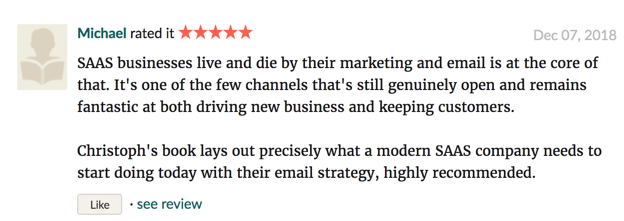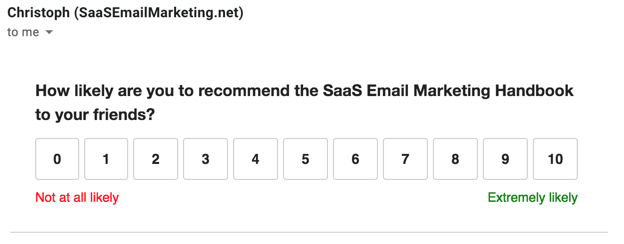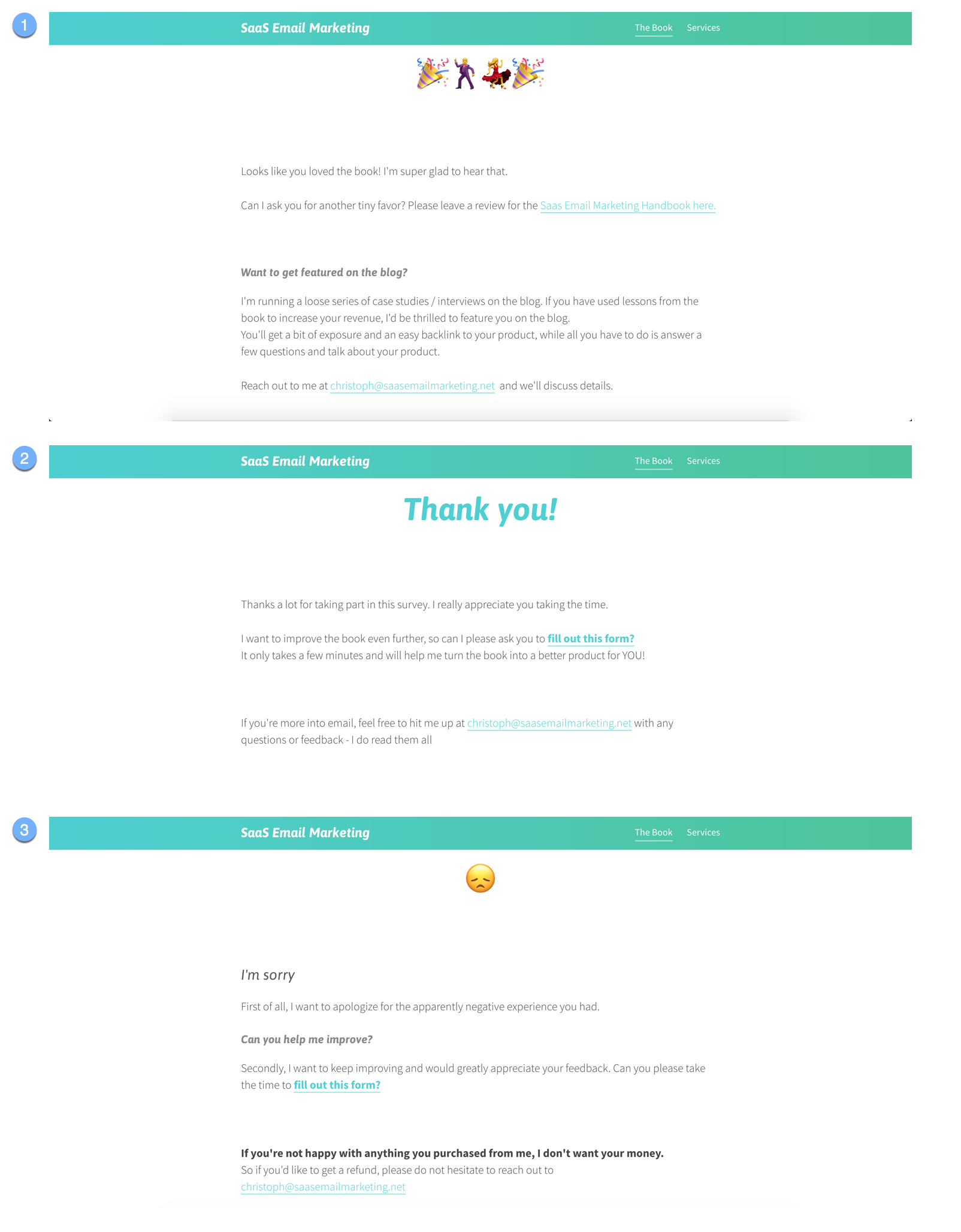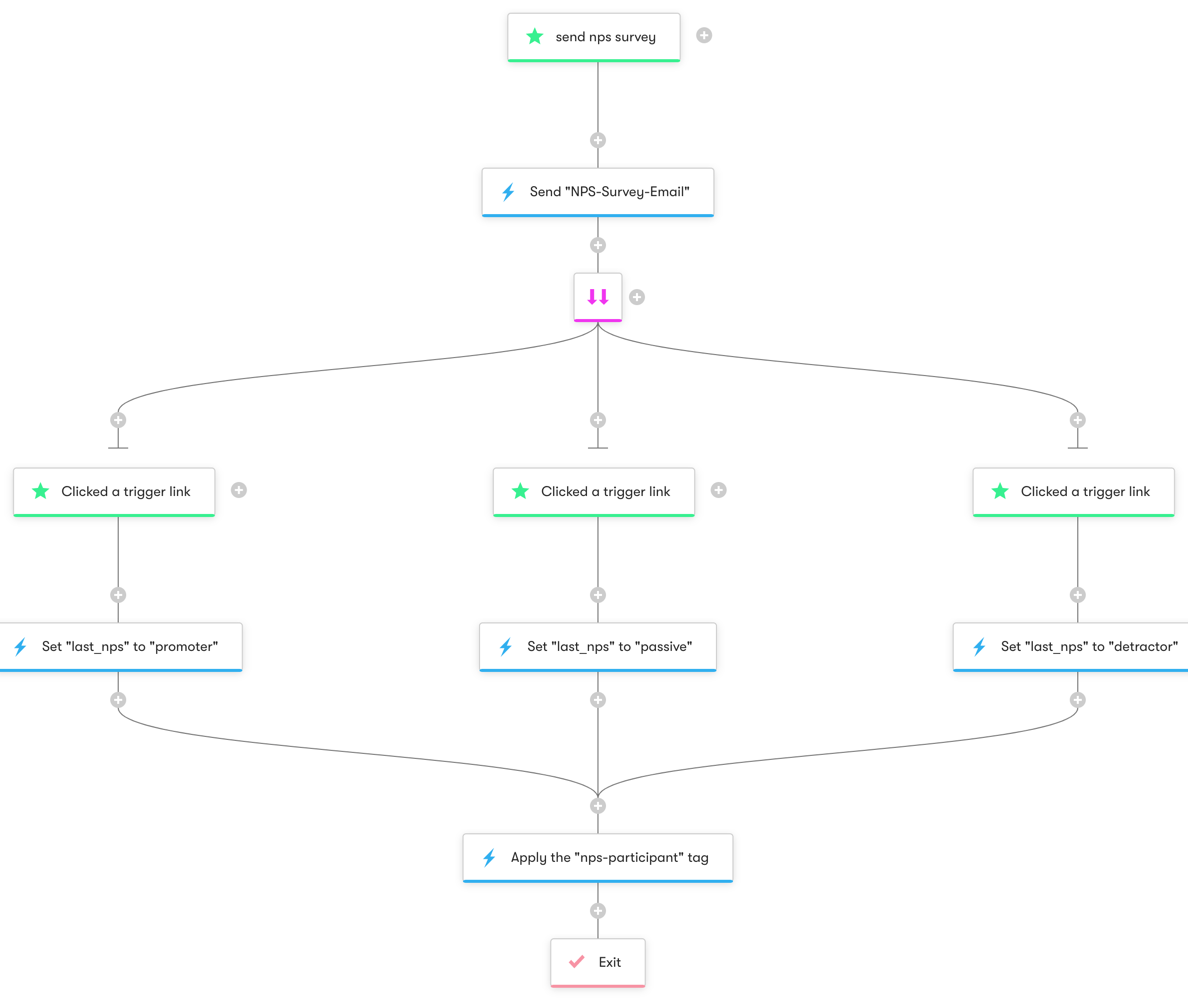In this article you'll learn how to set up a Net Promoter Score survey and gather more customer testimonials to display on your website and in other marketing material. You'll learn to do all of this with Drip and Google Docs in less than 60 minutes.
You'll learn to leverage the same tactic I used to get more reviews for my book. More reviews like this one:

What is Net Promoter Score?
Net Promoter Score, or NPS, is a benchmark for customer satisfaction and a tool that can predict business growth. Invented by Fred Reichheld in 2003 to demonstrate a company’s performance in the market, it has since then been adopted by thousands of businesses. Today, NPS is a trademark of Fred Reichheld, Satmetrix, and Bain & Company.
The tool - that is now used in over 150 countries - started with a research conducted by Fred Reichheld and the Bain team. Using information from Satmetrix, the team set out to ask different questions to study customer behavior.
The question that resulted in the highest correlation with customer satisfaction and word-of-mouth was:
What is the likelihood that you would recommend this company to a friend or colleague?
Your customers then answer this question with a score from 0 to 10.
The research revealed that companies which gained high scores from this question have more referrals and repeat purchases, which is linked to business growth. This simple question, yielded valuable data that led Reichheld to publish a Harvard Business Review article titled “The One Number You Need to Grow”.
The answers are classified into three groups:
- Promoters
- Passives
- Detractors

What is a Promoter in NPS?
When customers are prompted with the NPS question, “On a scale of 0 to 10, where 0 is Not at All Likely and 10 is Extremely Likely, what is the chance that you would recommend this to your friends?”, the ones who give you either a 9 or a 10 are called Promoters.
Promoters are your most loyal customers and brand enthusiasts. You must take care of Promoters because they are the customers who fuel your company’s growth.
Learn from companies that have a high NPS score like Apple. The iPhone and Mac makers are known to be consistent in delivering quality products. Aside from this, users also prefer Apple because of the company’s zero-risk customer service. When people buy an Apple product, they are confident that they can get help from the many Apple stores in case of issues.
Promoters are key players to help you determine what practices you should continue or what brand features are popular among your customers.
What is a Passive in NPS?
In NPS, the Passives are the survey respondents who give you a score between 7-8. Passive customers are satisfied with your product, but they are not enthusiastic enough to be considered brand loyalists.
When presented with alternate deals from other companies, Passives are likely to take up that offer.
Passives keep you on your toes - you can’t be too complacent when there are customers who are likely shopping around for a better alternative. These customers may consider other brands because of competitive pricing and better customer service. Passives keep you aware of what’s happening in your industry, specifically when it comes to your competitors’ performance.
What is a Detractor in NPS?
Detractors are the survey respondents who give you a score between 0-6. These customers may not be happy with your product, have experienced dissatisfying customer service, or have had an issue with order and payment.
Detractors can put your company at risk - one rant on social media that goes viral can cost your credibility. However, Detractors are important because they shed light on what needs to be improved.
Detractors help you determine if issues that displease customers are isolated or common to help you come up with solutions.
Why Use Net Promoter Score?
There are other similar tools that can measure customer satisfaction and help you monitor the performance of your business, so why should you go for NPS?
- It’s fast and easy to implement.
- The main question, “How likely are you to recommend this company to a friend?” can be followed up by 1-2 follow-up questions to determine why customers answered the way they did.
- It gives you the bigger picture in terms of customer appreciation.
- It identifies your enthusiastic customers. When you know your brand’s most ardent supporters, you can learn your strengths and highlight them in your marketing.
- It alerts you of dissatisfied customers, so you can act immediately. NPS helps you prevent negative customer experience from spreading and causing more damage
How to Calculate NPS Score
Calculating your Net Promoter Score is simple. After gathering the responses of the customers, subtract the percentage of Detractors or unhappy customers from the percentage of Promoters or the customers who favor your brand.
The formula should look like this:

NPS Score Range
Your Net Promoter Score can fall anywhere between -100 and +100. Positive scores mean that the number of Promoters is bigger than the number of your Detractors. A +100 NPS score then would mean that every customer surveyed is a Promoter and in contrast, a negative score means you have more Detractors than Promoters.
Net Promoter Score Calculation Examples
Example #1:
Suppose you received 100 responses from your survey. 70 responses gave you a glowing score of 9-10 and so come from Promoters. 10 of the responses gave you a score ranging between 0-6 and are considered Detractors. 20 customers gave you 7-8 scores, which fall under Passives.
Calculating the percentage of each group, you get 70% Promoters, 10% Detractors, and 20% Passives.

Note that NPS is always shown as a whole number and not a percentage so your Net Promoter Score is 60 and not 60%.
Example #2: Take another example: You surveyed 83 customers of which 11 were Promoters (13%) and 38 (or 46%) were Detractors. Here's the result for that:

What is a good NPS Score?
After you’ve gathered data from your NPS survey, you want to know if you did well.
Are your customers willing to recommend your company? Are they less likely to do business with you again? Your NPS score will answer these questions and evaluate customer satisfaction. A good NPS score will tell you that your customers are highly likely to recommend your company to others and a low one says you are less likely to expect referrals. So, what is a good NPS score?
Based on international standards, scores are interpreted as the following:
- 0 and above - Good
- 50 and above - Excellent
- 70 and above - World Class
Getting Customer Testimonials
But here's the cool thing about Net Promoter Score beyond just having a shiny number: It makes it super easy to get a hold of your most ardent fans (Promoters!) and nudge them to give you testimonials AND reviews. Getting great customer testimonials is essential for your marketing department.
Why testimonials are important
Your customer testimonials are important for copywriting because it gives you an idea of how your target audience talks about your product.
Finding the right voice to talk to your customers on your website - which pains to address, promises to make, etc. - is the foundational step of good website copy.
Another reason why testimonials are important is social proof. Social proof is an essential tool in the conversion optimization toolbox. Here's an example of a testimonial I use on my website:

How do testimonials help?
Secondly, each testimonial you put on your website needs to counter the most common objection buyers have at this step in their customer journey. Here are a few examples which objections you must counter at each step:
- On the landing page: "Is this product the right one for me? Can this company be trusted?"
- Opt-in page for your mailing list: "Will the emails I get be worth it? Will this teach me to solve my problem?"
- Pricing page: "This thing is EXPENSIVE!?!"
You can counter the objection on the landing page with someone similar to your visitor - e.g. if you're selling mostly to bootstrapped founders, you might feature another (celebrity) bootstrapper.
On the opt-in page you can put a testimonial from a customer that talks about what they learned from your emails and how this has helped their business.
On the pricing page, you can add a testimonial from a customer who made $29,836 in the first year of using your product. And so on and so forth for all the pages on your website.
The key take-away is: customer testimonials help you overcome customer objections. Have the right testimonial on each page and your conversion rate will thank you.
The Right Way of Asking for Testimonials
There's no right way of asking for customer testimonials per se. It all depends on what stage you're in and what exactly you're looking for.
Pre-Launch you might want to just reach out to friends and fellow-entrepreneurs for technically correct testimonials. Technically correct here means, that they probably haven't used your product (it's not launched - remember?) and they'll just say nice things about you or the underlying principle your product builds on.
For example, when you build a cold email outreach SaaS product you get someone like Noah Kagan to say something good about cold email - maybe "Cold email has made me billionaire!".
Alternatively, you can look through your existing communication with beta testers, investors or other people you've talked with about your idea. You can often find some golden testimonials in the conversations you already had.
Post-Launch you (hopefully) have a bunch of customers that you can ask for testimonials. I'll show you in a minute how you can use Drip, a Net Promoter Score survey, and Google Forms to collect customer testimonials with ease.
But before we go into that, let me give you a few more tips on asking for testimonials:
- Look for specific situations that made your customers happy. What feature did they love? Was your support exceptional?
- When you plan to counter a specific objection, ask your customers specifically about that
- Make sure your customer knows that you want to use the testimonial (and their personal details) on your website. Get their okay before you put it live
- Consider adding a link to their website (without visual highlighting) in the testimonial as a little thank you
How to Write a Good Testimonial
Most testimonials you read on a website are as dry as James Bond's Martini.
That's because someone in the marketing department decided it would be good to have testimonials, thought something up, wrote it down, and then asked one of their customers whether they would say that about the product.
Why not ask someone from the State Department to write your testimonials for you? That should be fun to read.
No, no, no! To help stir things up and show you how to write a good testimonials, here's how I approach the topic.
First of all, you never write your own testimonials. It's a stupid idea. The only time a testimonial sounds like it comes from your customer is when it comes from your customer!
So you take what customers are saying about you and your product and edit it lightly. You don't want to lose your customer's own unique voice. It's what makes the testimonial work in the first place. I recommend to shorten the testimonial, but not to change words or add stuff.
Lastly, for maximum effect include the full name, company, position, and an image of the person giving you a testimonial when displaying the customer testimonial on your website.
Questions to Ask for a Testimonial
Here are a few questions to ask when you are looking for testimonials. These are perfect when you ask your Promoters for testimonials and feedback on an on-going basis, just the way I'll show you in a few moments in this article.
- What positive impacts have you experienced from using the product?
- What do you like most about the product?
- Which feature do you like most about the product and why?
- How much money are you making because of the product?
- How has the product transformed your business?
How to Collect More Customer Testimonials with NPS Surveys
Now for the meat and potatoes...
Here's how we are going to leverage Drip and Google Forms to collect more customer testimonials from your
Promoters and get valuable feedback from your Passives & Detractors at the same time.
This is the 3-step master plan: 1. We set up an NPS survey in Drip 2. We send Promoters, Passives, and Detractors each to their own landing page 3. The landing page asks Promoters to leave a testimonial (via Google Forms), while Passives & Detractors get asked for feedback
Here's what that looks like for a Passive customer:
With NPS, you can collect more specific and straightforward testimonials that will encourage prospects to trust your business, counteract doubts caused by Detractors, and boost your credibility.
Here’s how you can use NPS when asking for testimonials:
- Set up an NPS Survey in your email marketing tool
- Send Detractors, Passives, and Promoters to different landing pages
-
for Promoters:
- Ask them to leave a review on Amazon, Capterra, Good Reads, and other sales channels.
-
for Detractors and Passives:
- ask the customers to provide feedback through a Google form
I've employed the same strategy for the SaaS Email Marketing Handbook. Every buyer gets this email:

And depending on which number/link you click on, you'll get redirected to one of three landing pages.

Setting up the NPS survey in Drip
Since I've built all my email marketing on Drip, I naturally used Drip to build out my Net Promoter Score survey emails.
It is surprisingly simple to do. All you need is a workflow that sends one email and three trigger links. Here's the overall layout of the workflow:

The important parts are sending the email and then registering which number the buyer clicked via trigger links. I've created trigger links that redirect to /nps/promoter/, /nps/passive/, and /nps/detractor/ respectively.
In the HTML for the email I linked up each number to the corresponding trigger link like this:

Now all that was missing were the landing pages, which you can build with any tool you want. I used middleman for this but Leadpages, Unbounce, etc. will work just as well.
How to get awesome customer testimonials with NPS surveys - conclusion
Now it is your turn to set up the same workflows and start gathering more testimonials to use on your website and in your copy. This email marketing automation tactic adds incrementally to your marketing flywheel and gets it spinning.
Your business should be enabling your dreams
Crank up your SaaS growth to 11 with the right email marketing & automation workflows. Sign up and learn how to:
- improve customer retention
- make your funnel overflow with leads
- get more word-of-mouth going for your SaaS
- BONUS: Free sample chapter from my book